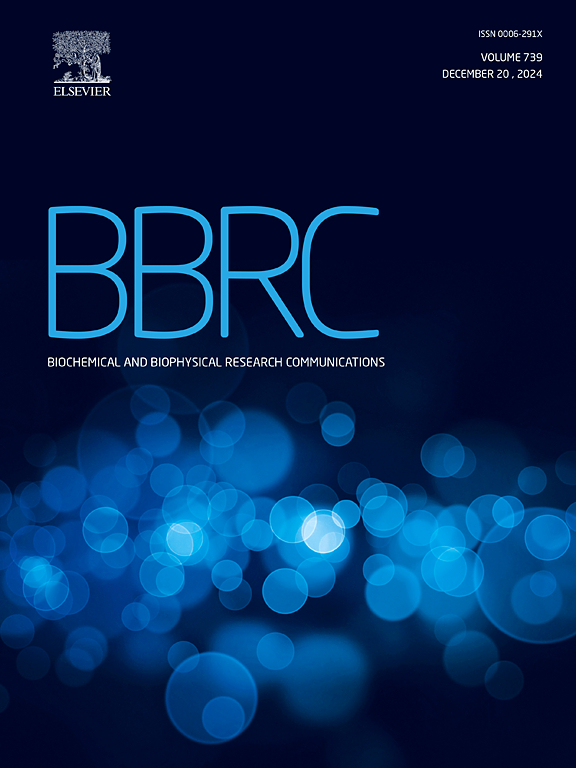6′-sialyllactose prevents dexamethasone-induced muscle atrophy by controlling the muscle protein degradation pathway
IF 2.5
3区 生物学
Q3 BIOCHEMISTRY & MOLECULAR BIOLOGY
Biochemical and biophysical research communications
Pub Date : 2024-10-24
DOI:10.1016/j.bbrc.2024.150892
引用次数: 0
Abstract
Sarcopenia is associated with various geriatric diseases, such as gait disorders, falls, malnutrition, and osteoporosis. Accordingly, interest in the prevention and treatment of sarcopenia has grown over the years. The human milk oligosaccharide (HMO) 6′-sialyllactose (6′-SL) is known to improve exercise performance, reduce muscle fatigue, and improve GNE myopathy; however, its effect on sarcopenia has not yet been reported. In this study, we aimed to investigate the efficacy of 6′-SL in dexamethasone-induced muscle atrophy, which is a widely used model for the study of sarcopenia. The effects of 6′-SL on differentiated C2C12 skeletal muscle cells and on mice were examined by treatment with 6′-SL in the presence or absence of dexamethasone. 6′-SL was found to inhibit the dexamethasone-induced decrease of MHC expression, as well as to prevent reduction in the number, length, and width of myotubes. Furthermore, the dexamethasone-induced upregulation of myostatin, muscle RING-finger protein-1 (MuRF1), and atrogin-1 were also inhibited by 6′-SL treatment. In mice, intraperitoneal administration of dexamethasone caused decreases in muscle fiber diameter, muscle weight, and exercise performance, most of which were significantly inhibited by oral treatment with 6′-SL. Therefore, utilization of 6′-SL could contribute to the prevention and treatment of muscle atrophy and sarcopenia.
6'-sialyllactose 通过控制肌肉蛋白降解途径,防止地塞米松诱发的肌肉萎缩。
肌肉疏松症与各种老年病有关,如步态障碍、跌倒、营养不良和骨质疏松症。因此,多年来人们对预防和治疗肌肉疏松症的兴趣与日俱增。众所周知,人乳寡糖(HMO)6'-sialyllactose(6'-SL)可改善运动表现、减轻肌肉疲劳并改善 GNE 肌病,但其对肌肉疏松症的影响尚未见报道。本研究旨在探讨 6'-SL 对地塞米松诱导的肌肉萎缩的疗效。在地塞米松存在或不存在的情况下,用 6'-SL 处理分化的 C2C12 骨骼肌细胞和小鼠,研究了 6'-SL 对它们的影响。研究发现,6'-SL 能抑制地塞米松引起的 MHC 表达减少,并能防止肌管数量、长度和宽度的减少。此外,地塞米松诱导的肌生长因子、肌肉环指蛋白-1(MuRF1)和阿托品-1的上调也受到了6'-SL的抑制。对小鼠腹腔注射地塞米松会导致肌纤维直径、肌肉重量和运动表现下降,而口服 6'-SL 会显著抑制其中的大部分。因此,利用 6'-SL 有助于预防和治疗肌肉萎缩和肌肉疏松症。
本文章由计算机程序翻译,如有差异,请以英文原文为准。
求助全文
约1分钟内获得全文
求助全文
来源期刊
CiteScore
6.10
自引率
0.00%
发文量
1400
审稿时长
14 days
期刊介绍:
Biochemical and Biophysical Research Communications is the premier international journal devoted to the very rapid dissemination of timely and significant experimental results in diverse fields of biological research. The development of the "Breakthroughs and Views" section brings the minireview format to the journal, and issues often contain collections of special interest manuscripts. BBRC is published weekly (52 issues/year).Research Areas now include: Biochemistry; biophysics; cell biology; developmental biology; immunology
; molecular biology; neurobiology; plant biology and proteomics

 求助内容:
求助内容: 应助结果提醒方式:
应助结果提醒方式:


